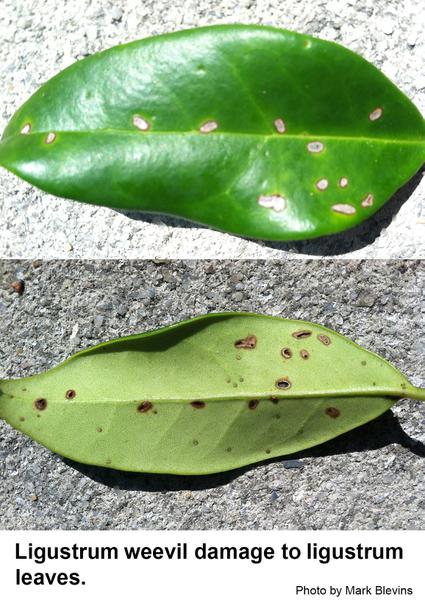Description and Biology
The ligustrum weevil, Ochyronmera ligustri, was first described from Wake County, NC, in 1959. This weevil is shiny brown with golden-yellow hairs (setae). It usually has a median stripe and an obscure lateral stripe. The prothorax is wider than it is long and strongly rounded on the sides. The insect is about 3/16 inch long, and the rostrum or "bill" is variable but conspicuous. It chews small, irregular holes mostly on the undersides of privet leaves. This weevil is a minor and infrequent pest in privet plantings. Adult feeding takes place in late June or early July. Damage does not seem to occur every year so damage may not even be noticed in following years. This insect is most abundant in late June or early July, but adults can be hard to spot because they feed mostly at night and they immediately drop to the ground when disturbed. These weevils prefer wilted foliage. About the first of July, females lay eggs in seed capsules or fleshy fruit as soon as the fruit is well formed. A small, slightly curved incision can be seen on the fruit where the egg has been deposited. In a few weeks the eggs hatch, and the small, legless grubs feed in the fruit or seed capsules throughout the fall and winter. The grubs first feed on the fruit and seed capsule and then burrow into the seed. Grubs mature and molt into pupae in April. Adults may emerge from ligustrum seeds as early as mid-May and then feed on the leaves and pollen. There is one generation per year. Though unsightly, the damage does not threaten the health of infested shrubs.
Host Plants
Ligustrum weevils favor Japanese privet but also feed on common privet, glossy privet, and lilac. This weevil has also been reported on grape. With their chewing mouthparts the weevils cause jagged holes in the leaves as they feed. They sometimes destroy the buds, causing bunchy growth and a tattered appearance.
Residential Recommendations
Applying a contact insecticide labeled for residential landscape pest management in late June should protect against the weevils. For an alternate control, shearing off and destroying the berries in the fall or winter should help reduce ligustrum weevils.
References
- Biology and life history of the ligustrum weevil (Curculionidae). Wray, C. L. 1961. The Coleopterists' Bulletin 15(4): 119-120.
- Common name: ligustrum weevil (suggested common name), scientific name: Ochyromera ligustri Warner (Insecta: Coleoptera: Curculionidae: Tychiinae: Tychiini: Endaeina). Cuda, J. P. and M. C. Zeller. 2005 (revised 2014). Featured Creatures, Entomology & Nematology, FDACS/DPI, EDIS. Publication Number: EENY-343.
- First Record of Ochyromera ligustri (Coleptera: Curculionidae) from Chinese Privet in Florida. Cuda, J. P. and M. C. Zeller. 1998. Florida Entomologist 81(4): 582-584.
- Insect and Related Pests of Shrubs. Baker, J. R. ed. 1980. NC Agricultural Extension Service publication AG-189. 199 pp.
- The natural enemies of privets (Ligustrum: Oleaceae): a literature review, with particular reference to biological control. Shaw, R. H., M. J. W. Cock, and H. C. Evans. CAB Reviews 2018 13, No. 011. 24 pp.
- Extension Plant Pathology Publications and Factsheets
- Horticultural Science Publications
- North Carolina Agricultural Chemicals Manual
For assistance with a specific problem, contact your local N.C. Cooperative Extension Center.
This Factsheet has not been peer reviewed.
Publication date: Sept. 16, 2016
Revised: Oct. 1, 2019
Recommendations for the use of agricultural chemicals are included in this publication as a convenience to the reader. The use of brand names and any mention or listing of commercial products or services in this publication does not imply endorsement by NC State University or N.C. A&T State University nor discrimination against similar products or services not mentioned. Individuals who use agricultural chemicals are responsible for ensuring that the intended use complies with current regulations and conforms to the product label. Be sure to obtain current information about usage regulations and examine a current product label before applying any chemical. For assistance, contact your local N.C. Cooperative Extension county center.
N.C. Cooperative Extension prohibits discrimination and harassment regardless of age, color, disability, family and marital status, gender identity, national origin, political beliefs, race, religion, sex (including pregnancy), sexual orientation and veteran status.


